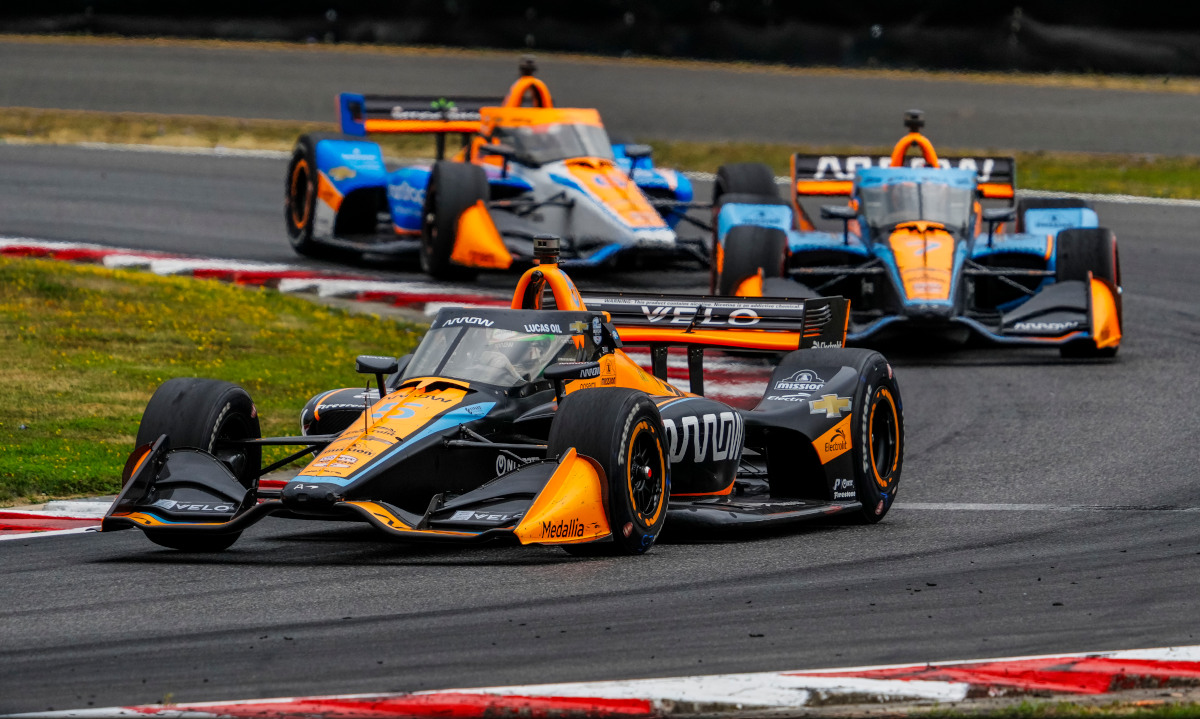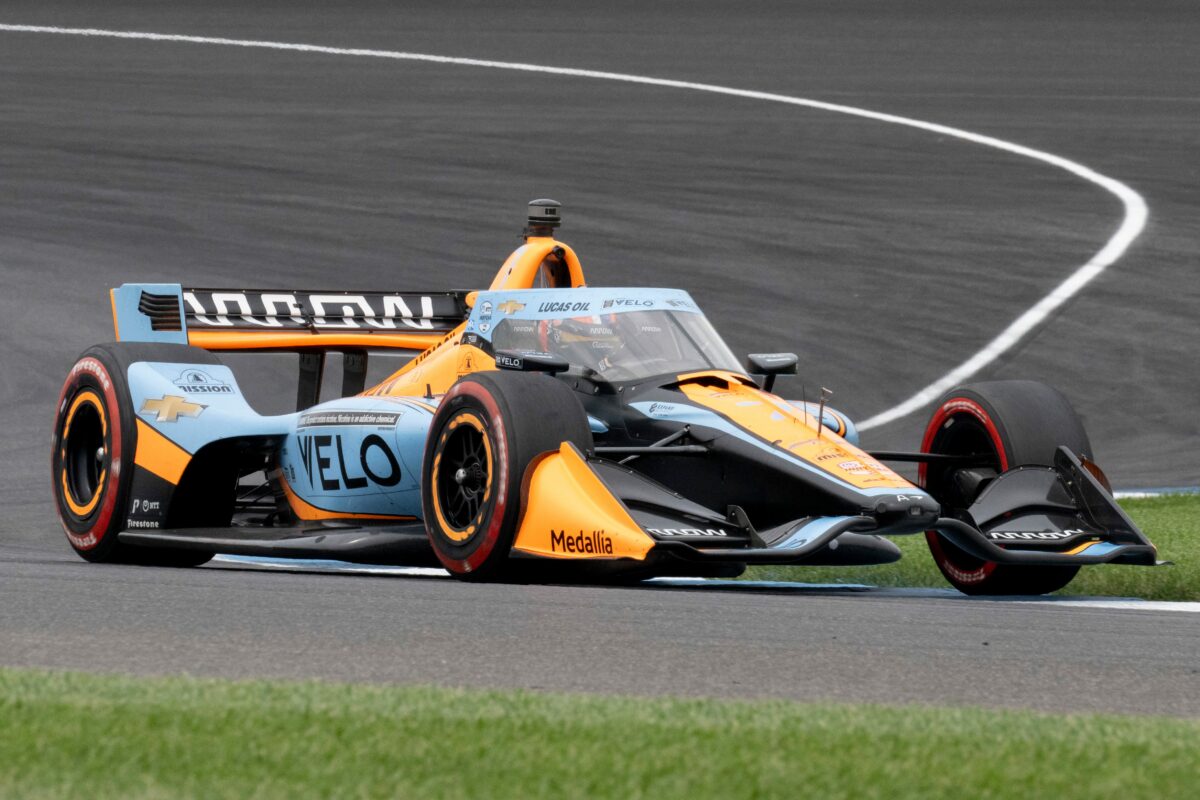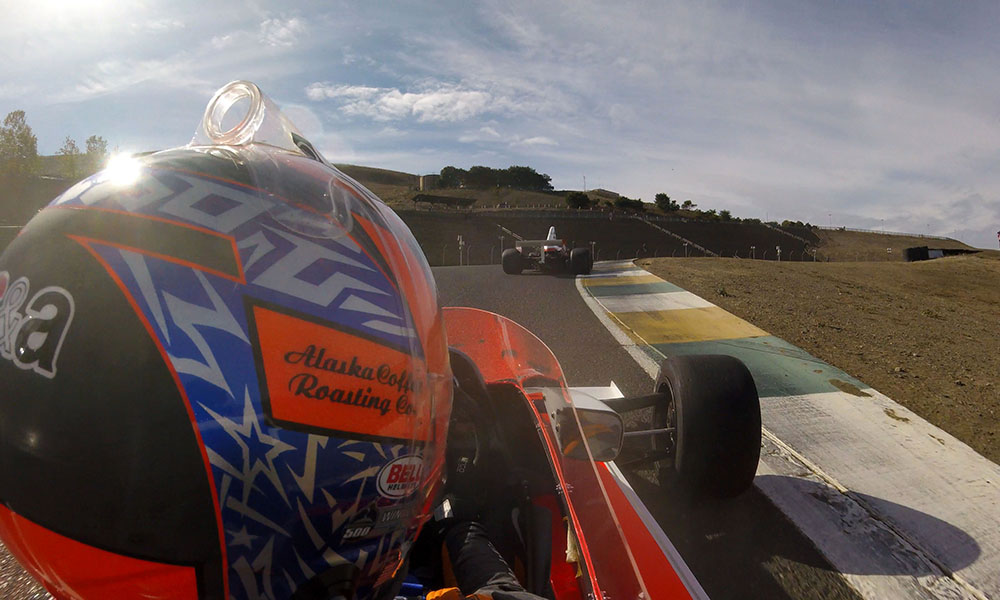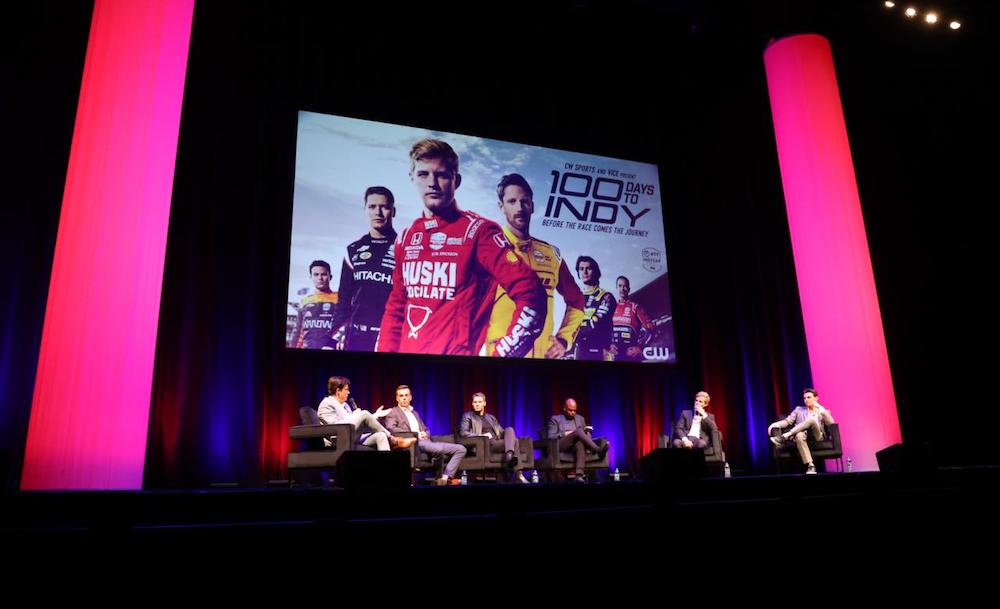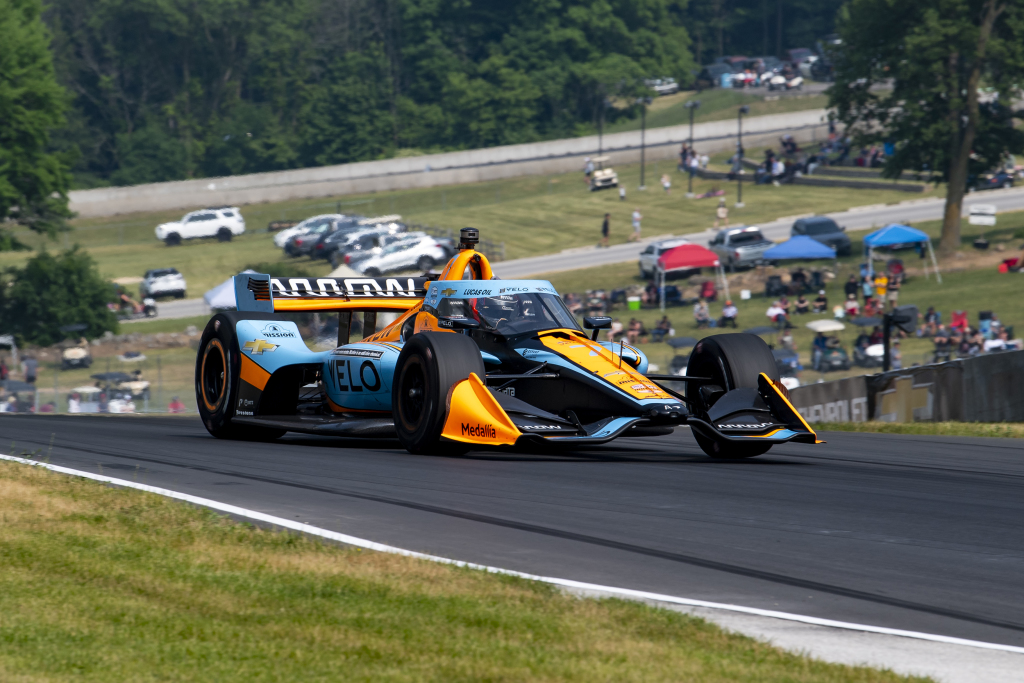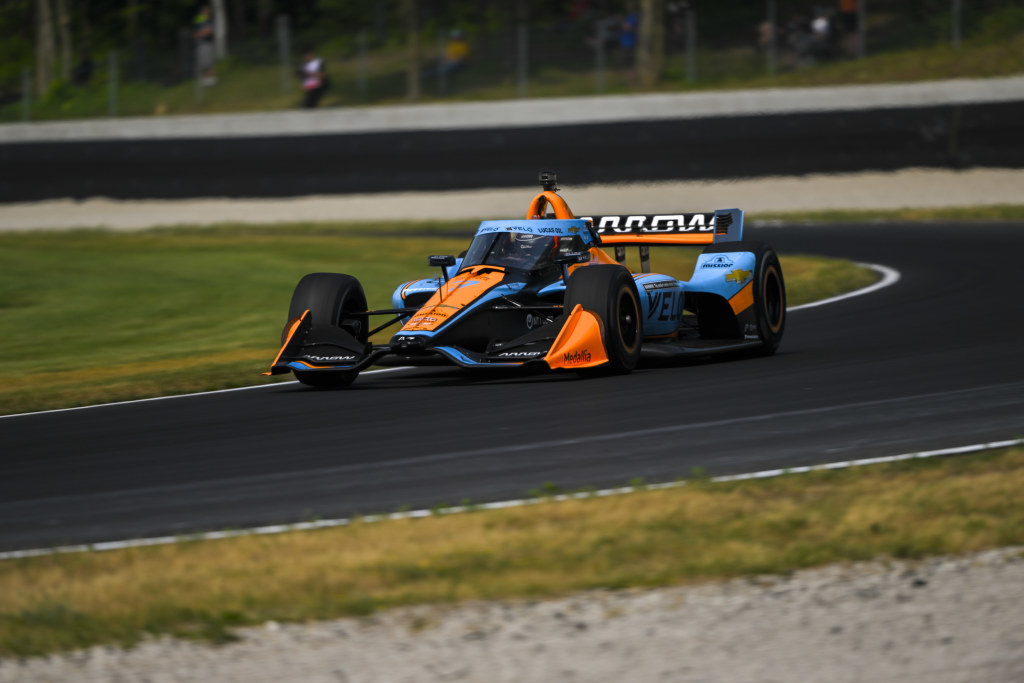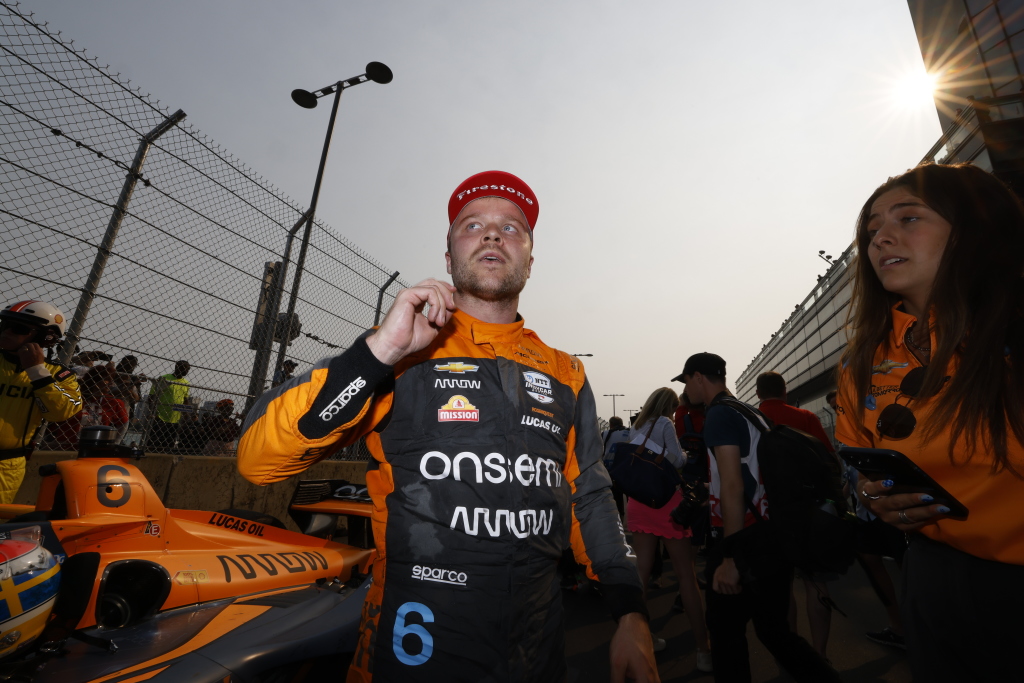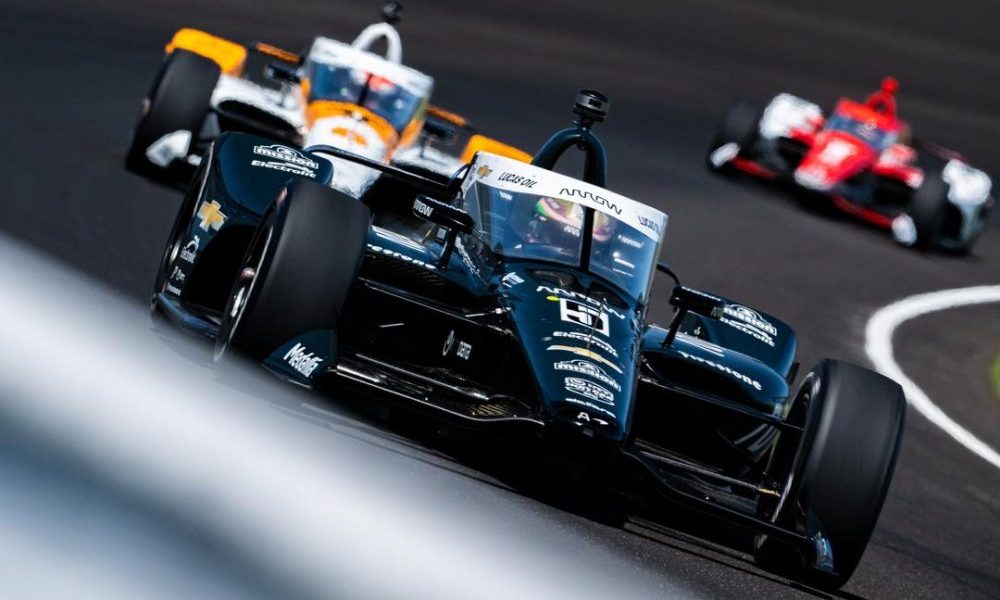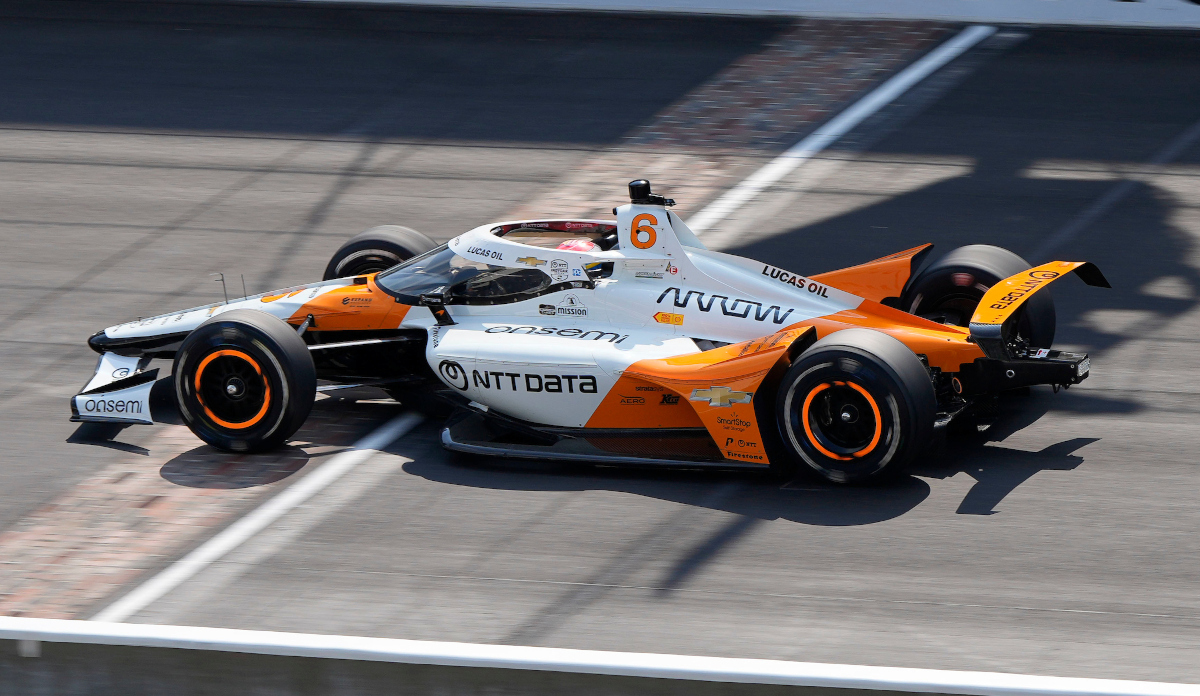Arrow McLaren
No. 5 Chevy: Pato O’Ward (4th in 2023 championship)
No. 6 Chevy: David Malukas (17th in 2023 championship with Dale Coyne Racing)
No. 7 Chevy: Alexander Rossi (9th in 2023 championship)
THINGS TO KNOW
One, two, or three?
Arrow McLaren doesn’t find itself in the same exact position as Andretti Global with needing to break free from its recent mediocrity, but there is a parallel in needing to break free from the vast expanse that separates it from Chip Ganassi Racing and Team Penske.
As a two-car team, Pato O’Ward was Arrow McLaren’s best and only contender to apply pressure to Ganassi and Penske from 2020-2022, but with the increase to three cars in 2023, his status as Arrow McLaren’s lone title challenger remained unchanged.
Bringing Alexander Rossi on board last year to join O’Ward and Felix Rosenqvist was done with the expectation for the Indianapolis 500 winner to provide the team with a stronger presence towards the front of the field—to give O’Ward another running partner—and give Arrow McLaren at least a dual threat at every round like Ganassi has with Scott Dixon and Alex Palou and Penske has with Josef Newgarden and Scott McLaughlin. But that didn’t happen.
That’s the main mission for the team to establish in 2024. Although O’Ward went winless last season, he lived on the podium, and through those seven top threes, he was able to shadow the two top teams. The outgoing Rosenqvist took two poles and made two trips to the podium while Rossi made one trip to the podium, which is where the disparity is most readily identified.
For Arrow McLaren to shorten or erase the gap to Ganassi and Penske, getting back to victory lane with O’Ward and dialing up the podiums for Rossi — and resuming his winning ways — is a must. At least two of its cars have to be in the hunt wherever they race if Arrow McLaren is going to bridge that championship gap because their rivals are too strong for O’Ward to get the job done without help.
For the team to truly contend, it will need most of its cars near the front, taking valuable points that would otherwise be earned by their rivals, and making it a three-way attack with the entry meant to be piloted by the injured David Malukas would be a wonderful development for Arrow McLaren as a whole.
Titles are won as a team. How will this squad fare in that unwavering challenge?
[lawrence-related id=348696,348666]
LFGOOOOO time for Pato
The quality of Arrow McLaren’s championship competitiveness lives and dies with O’Ward. Separate from their squad goals, the 24-year-old Mexican is the team’s fastest and fiercest driver, and on an individual level, he’s also entering a crucial phase of his career.
Like his Indy Lights teammate Colton Herta, O’Ward’s been a force in the championship for most of his time in IndyCar, but small issues have kept him from breaking through to lead the standings for significant lengths of time. Streaking away from pole and building a huge lead has been impressive, but the accelerated tire wear awaiting O’Ward on the second half of a stint has turned a few too many big results into lesser ones. Looking at the task ahead, the burning motivation to prove he’s faster than everyone must be left in the past.
This is the year where he needs to find and strike the balance between attacking and conserving because that’s how IndyCar championships are won. That’s the formula all of the most recent title winners have used to such great effect, and in 2024, that’s precisely what O’Ward needs to deliver if he’s going to take that final step to reach his full potential.
With five seasons of experience to draw from — the last four at Arrow McLaren — the spotlight if firmly placed on O’Ward to take the team to the promised land, and that will only happen if he’s locked into a ‘big picture’ mindset from the first race.
Nobody would accuse Ganassi’s Alex Palou of being IndyCar’s fastest pilot, but he’s already a two-time champion who is of a similar age to O’Ward and entered the series as a full-timer in the same season. If there’s a blueprint for him to follow in this quest, it’s Palou. (And we’ll leave the topic of Palou almost becoming his teammate alone for now…)

It’s a lot to ask of any driver, but he and the team can’t afford to stay in that second-best category any longer. A new contract extension speaks to the faith Arrow McLaren has in O’Ward, and no team spends more on its program—including its engineering resources—than this one. The weight of expectations on its lead driver cannot be underestimated.
The old line about extreme pressure either bursting pipes or making diamonds comes to mind here for O’Ward. If he’s fortunate, Rossi and Malukas will take away some of that pressure by joining him in the thick of the action.
The days of Arrow McLaren being happy with coming close to the championship heavyweights are officially over and IndyCar’s most popular driver is the one carrying all of the team’s hopes to deliver.
Engineering shuffle
Arrow McLaren lost one of its greatest engineering minds in Craig Hampson shortly after the last season concluded. He was specifically targeted by Rossi as the engineer he wanted to work with upon joining the team, but it only lasted one year when Hampson decided he needed a break from the sport.
In his place, team veteran Chris Lawrence, Rosenqvist’s race engineer from 2023, has been moved from the No. 6 car to Rossi’s No. 7, and based on how Rosenqvist raved about all aspects of Lawrence’s capabilities, Rossi is in good hands and should be able to take another leap forward with the team.
With Lawrence’s absence creating a vacancy in the No. 6, Arrow McLaren has surfaced a team veteran in Blair Perschbacher, who was Robert Wickens’ race engineer when he blitzed the series as a rookie in 2018, and assigned him to engineer Malukas (and his stand-in) this year. It’s a strong choice, and for Malukas, a calm, process-driven presence on the timing stand should help in his technical development.
New dynamic
O’Ward spent the last few years racing with his best IndyCar friend in Felix Rosenqvist alongside him in the team. They were a great twosome, didn’t let their inner competitiveness get in the way of being each other’s support system, and fit perfectly together within Arrow McLaren, with the Swede being the older and more mature driver in that dynamic.
That level of comfort and camaraderie won’t be the same with Rosenqvist gone to Meyer Shank Racing, but that might be a good thing for O’Ward. Rossi and Malukas are great to have at teammates, and Rossi’s maturity and business-like approach is beloved within the program, but if O’Ward’s going to grow into the true team-wide leader that he needs to be, it’s time—despite his relative youth—to take the reins, fill Rosenqvist’s void, and lead all aspects of the program among Arrow McLaren’s drivers.
It’s another big piece of his development puzzle. O’Ward’s been the de facto leader due to his team-leading speed and results, but that’s altogether different than stepping up to lead from the inside and shape the program in all the ways it needs.
Rossi in a prove-it year

It wasn’t the easiest year for Rossi as he learned to work with a new team, new teammates, and a new engine partner after spending 2016-2022 with Honda, but on debut, he did match his ninth-place championship run from his final season with Andretti Global. But ninth isn’t what he wanted, nor is it what Arrow McLaren needed because it already had something similar from Rosenqvist.
Beyond all of the points raised so far about the team being under the gun to displace Ganassi and/or Penske in the standings, and for Rossi needing to become a big player in that initiative by shadowing or beating O’Ward on a regular basis, we have the most pressing personal need for Rossi to handle, and that’s to earn a contract extension.
Entering the second of a two-year deal, the last thing Rossi can afford is to find himself four or five positions behind O’Ward after the Indy 500. If, like in 2023, the separation between them is hard to ignore, McLaren won’t be waiting to see how the rest of the season goes before opening talks with potential replacements.
This is a full and undeniable prove-it year for Rossi at Arrow McLaren, and every person within the team is rooting for him to succeed and receive another multi-year contract because he’s loved within the organization for all he brings. Rossi’s contributions in engineering debriefs, to the engine techs at Chevy, to the commercial and marketing side, and for always being an ultra-professional leader within the program are continually hailed as factors that have made him indispensable in just one season.
And with that deep foundation established, all Rossi needs to do is deliver in the same way he did when he placed second and third for Andretti in 2018-2019, respectively. For Rossi, 2024 is going to be a turning point in his career. It’s another instance of busting pipes or making diamonds. Once the season is over, he’ll either be staying with Arrow McLaren and prospering or hunting for a new team home.
Grace
One of the rising mechanical stars within Arrow McLaren is Grace Hackenberg. She’s still somewhat new to IndyCar, but Hackenberg has become a valued member of the pit crew, and this year, she’ll add to the growing ranks of women who go over the pit wall in all the races. Look for Hackenberg changing Rossi’s inside front tire at every round, which is a first for her.
A Malukas mystery to solve
Will the signing of David Malukas turn out to be the smartest out-of-left-field move in Arrow McLaren’s history? He wasn’t on their radar until some of the more established veterans on the free agent market became unavailable, so in the last month of the season, the team took a no-risk decision by bringing in the 22-year-old from Illinois on a prove-it deal of his own.
Malukas dealt with constant change over his two seasons at Dale Coyne Racing, which stunted his development. Even so, he managed to impress on a number of occasions, and especially on the ovals, which is what caught his new team’s attention. At Arrow McLaren, he has all of the personal and professional tools a young driver could want, and it’s here where Malukas can turn those occasional shining moments into more frequent appearances at the sharp end of the field.
In contrast to his teammates who are proven commodities, we just don’t know how high Malukas can rise because he’s entering his first opportunity to fight among the top two or three teams and show everyone what he’s made of. The question to answer is quite basic: What kind of talent does Malukas possess? Pitted against O’Ward, he’ll get an answer, and swiftly. The same goes with Rossi.
Once he’s able to start his season and he’s given a few races to settle in and get a feel for Arrow McLaren’s approach to chassis setup and Chevy’s approach to engine tuning, we’ll know if Malukas has a future with the team.
Based on his time at Coyne, he’s worthy of the chance to complement O’Ward and Rossi, but the same note about Rossi applies here. He wasn’t brought in to finish behind his teammates, and with a couple of really strong free agents for the team to consider for 2025, Malukas does need to stake his claim in the No. 6 or risk being one-and-done with Arrow McLaren.
Ilott looming?
Callum Ilott, who tested in place of Malukas in February, is expected to get the nod to drive the No. 6 at St. Petersburg and possibly more—the Thermal Club event is two weeks later, and there’s a group test at Barber in Alabama right after—that could be questionable for Malukas if he needs more time to heal after wrist surgery.
Make no mistake about Ilott and McLaren; the team is beyond curious to see how he integrates into the program and how he performs alongside its returning drivers. Ilott’s signed to do the full eight-race FIA World Endurance Championship calendar in the Hypercar class, so he does have a few date conflicts with IndyCar, but could be pressed into service by this team or others for more than half of the season if desired.
Only O’Ward is guaranteed to be with Arrow McLaren next year, so getting an early look at Ilott would go a long way to deciding whether he’d get an offer to come back as a full-timer if Rossi or Malukas aren’t kept. Among the other young IndyCar chargers, Rinus VeeKay and Christian Lundgaard are headed towards free agency at the end of the season (if they don’t sign extensions beforehand with their existing teams).
Put it all together and McLaren CEO Zak Brown, sporting director Tony Kanaan, and team principal Gavin Ward have some promising talent to pursue if the No. 6 or No. 7 would benefit from a competitive upgrade.
Pressure: It’s the common influence that links Arrow McLaren’s driving trio in big and vastly different ways in 2024.
Honoring Gil
Arrow McLaren will honor their late and beloved colleague Gil de Ferran on their cars and crew this season. It’s a classy move; along with logos placed on the three cars, look for pit crew members to sport de Ferran stickers on their helmets to pay tribute to the CART champion and Indy 500 winner who helped shape McLaren’s IndyCar and Formula 1 programs before his untimely death in December.
